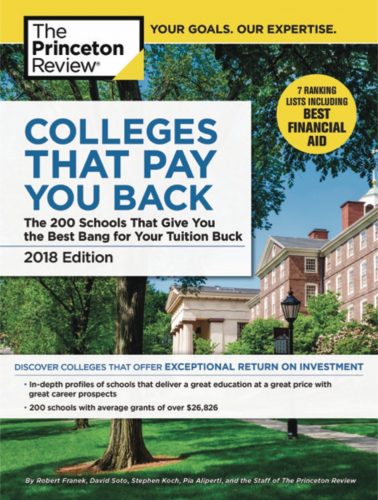The Princeton Review’s Annual “Colleges That Pay You Back” Book
The Princeton Review’s 2018 edition of Colleges That Pay You Back: The 200 Schools That Give You the Best Bang for Your Tuition Buck (Penguin Random House / Princeton Review Books).
This annual guidebook, now in its 4th year, is the education services company’s resource for college-bound students and their parents shopping for affordable, academically outstanding colleges that graduate their students to successful, rewarding careers.

The Princeton Review’s 2018 edition of COLLEGES THAT PAY YOU BACK: The 200 Schools That Give You the Best Bang for Your Tuition Buck is published January 16, 2018. (PRNewsfoto/The Princeton Review, Inc.)
Colleges That Pay You Back contains detailed profiles of the schools, plus seven ranking lists: one titled “Top 50 Colleges That Pay You Back” based on Princeton Review’s ROI ratings, and six “Top 25” lists (highlights follow).
The Princeton Review chose the 200 schools for this edition based on a comprehensive analysis of data from its surveys of administrators at more than 650 colleges in 2016-17. Survey topics broadly covered academics, cost, financial aid, career services, graduation rates, student debt, and alumni support.
The company also factored in data from PayScale.com surveys of alumni of the schools about their starting and mid-career salaries and job satisfaction. In all, more than 40+ data points were crunched to select the 200 schools for the book and tally its seven ranking lists.
“Only 7% of the nation’s four-year colleges made it into this book,” noted Robert Franek, its lead author and The Princeton Review’s Editor-in-Chief. “These schools were bona fide standouts for the return they deliver on one’s college investment. They offer stellar academics, generous aid awards to students with need and/or merit, and provide all of their undergrads with career services from day one plus a lifetime of alumni connections.”
Ranking Highlights
Stanford University (CA) took the #1 spot on the book’s main ranking list, “Top 50 Colleges That Pay You Back.” Midlist at #26 was the University of Chicago (IL) while the University of Florida was #50.
Six other ranking lists report top 25 schools in high-interest categories. The list titles and #1 and #25 schools on them are:
“Best Financial Aid”
#1 Bowdoin College (ME) / #25 Macalester College (MN)
“Best Career Placement”
#1 Harvey Mudd College (CA) / #25 Cornell University (NY)
“Best Alumni Network”
#1 Pennsylvania State University / #25 Union College (NY)
“Best Schools for Internships”
#1 Northeastern University (MA) / #25 Gettysburg College (PA)
“Best Schools for Making an Impact”
#1 Wesleyan University (CT) / #25 Kalamazoo College (MI)
“Top Colleges That Pay You Back for Students with No Demonstrated Need”
#1 Harvey Mudd College (CA) / #25 University of Michigan—Ann Arbor
Extraordinary Facts About the Colleges That Pay You Back 2018 Edition
Among the 200 colleges (135 private and 65 public) in the book:
- the average grant to students with need is $26,800
- the median starting salary of graduates is $55,700 and mid-career salary is $108,700.
Among the book’s 65 public colleges:
- the average net cost of attendance (sticker price minus average grant) for in-state students receiving need-based aid is $12,700
- the average admission rate is 53% and 12 colleges admit over 70%
Colleges That Pay You Back also has nine profiles of tuition-free colleges and a section listing “Great Schools for the Highest Paying Majors.” It is one of 150 Princeton Review books published by Penguin Random House in a line that includes The Best 382 Colleges, Colleges That Create Futures, and Paying for College Without Going Broke.
The Princeton Review’s Colleges That Pay You Back project is an expansion of its America’s Best Value Colleges guide that debuted in 2004 and was inspired by the findings of the company’s 2003 College Hopes & Worries Survey. This annual survey, now in its 16th year has polled more than 141,000 college applicants and parents about their college perspectives.
Among the 2017 survey findings reported in March 2017: 99% of respondents viewed college as “worth it,” but 98% said “financial aid would be necessary” to pay for it (65% of that cohort deemed aid “extremely necessary”). A plurality saw the main benefit of the degree “a potentially better job and higher income.”






